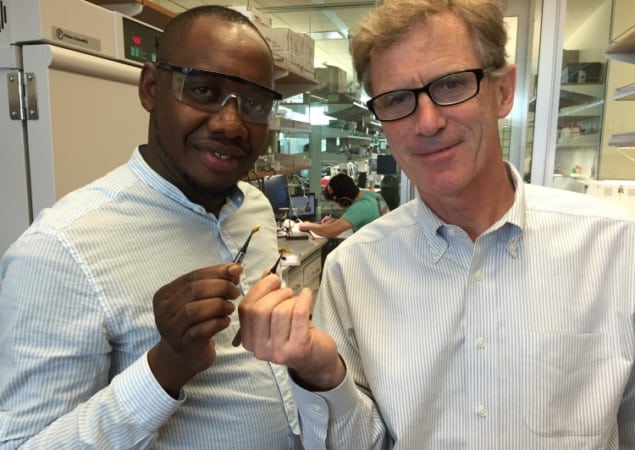
Implanted cortical microelectrode arrays can be used to record and stimulate neural activity, enabling studies of neural circuit function and treatment of many chronic diseases. The reliability of such arrays, however, is limited by insertion trauma and the foreign body response, which can lead to electrode encapsulation and neuron damage. Minimizing these tissue responses is vital for future development of brain-machine interfaces.
The impact of such tissue reactions depends upon factors including the electrode materials, and the size and geometry of the implanted microelectrodes. With this in mind, researchers from the University of Texas at Dallas and Boston University are developing microelectrode arrays based on amorphous silicon carbide (a-SiC). The arrays contain shanks (the parts that penetrate neural tissue) with a maximum transverse dimension of 10 µm and a cross-sectional area of below 60 µm2 (J. Neural. Eng. 15 016007).
“Recording and stimulation of neural activity is greatly influenced by the distance between the electrode site and the target neuron or neuronal network,” explained first author Felix Deku from UT Dallas’ Neural Interfaces Laboratory. “The small shank dimensions of our devices will reduce tissue damage during implantation and minimize the foreign body response, thereby increasing the possibility of our electrodes to be in close proximity to healthy neurons.”
Electrodes for recording neural activity work best with low impedance, while high charge-injection capacity is required for safe stimulation. The tiny shanks in these arrays have electrode sites with extremely small geometric surface areas (from 20–200 µm2). Consequently, they exhibit higher impedance and lower charge-injection capacity than typical silicon-based microelectrodes.
This small size does, however, confer a unique advantage. With one dimension smaller than 25 µm, the electrode sites meet the criteria to act as ultramicroelectrodes (UMEs). “Ultramicroelectrode behaviour allows for hemispherical migration of counterions to the neural interface and produces a substantial increase in the injectable charge per unit area compared to microelectrodes,” said Deku.
To improve stimulation and recording capabilities further, the team also investigated the use of low-impedance coatings – of titanium nitride (TiN) or sputtered iridium oxide (SIROF) – on the electrode sites.
Electrochemical characterization
The researchers chose a-SiC to create the implantable devices as is well-tolerated in the cortex and highly stable in saline. It is also amenable to standard thin-film fabrication processes. For this study, they used plasma enhanced chemical vapor deposition to deposit a-SiC films that completely encapsulate the metal interconnects, and created electrode sites by etching openings in the top of the a-SiC.
Deku and colleagues fabricated a-SiC microelectrode arrays with 16 penetrating shanks, each having a cross-sectional area less than 60 µm2. They characterized the electrochemical properties of gold and gold/platinum UMEs, as well as gold UMEs coated with SIROF or TiN. Cyclic voltammetry revealed cathodal charge storage capacities of 35 and 12 mC/cm2, for SIROF and TiN-coated UMEs respectively, compared with 10 and 2 mC/cm2 for uncoated platinum and gold UMEs, respectively.

Electrochemical impedance spectroscopy demonstrated that coating gold electrodes with SIROF reduced their average impedance at 1 kHz from 2.86 MΩ to 90.2 kΩ, while a TiN coating reduced the impedance to 31.1 kΩ. Finally, the team investigated the ability of the coated UMEs to deliver charge. The maximum charge injection capacity for SIROF-coated UMEs was 3.4 mC/cm2 at 0.0 V anodic bias and 15.3 mC/cm2 at 0.8 V bias; for TiN, these values were 3.2 and 6.2 mC/cm2 at 0.0 and 0.8 V. They point out that these values are notably larger than those reported for similar coatings on larger microelectrodes.

In vivo experiments
Finally, the researchers evaluated the ability of the a-SiC microelectrode arrays to provide neural recordings in vivo. For intracortical studies, they fabricated arrays with 16 penetrating shanks with one electrode per shank. Each shank was 4–5 mµ thick, 9 mµ m wide, 4 mm in length and terminated in a sharp point.
The researchers implanted a microelectrode array with 100 mµ m2 platinum UMEs in the basal ganglia nucleus of an anesthetized zebra finch. Immediately after implantation, they recorded neuronal spike waveforms demonstrating single unit spiking activity. The 16 recorded channels showed no strong coupling between contacts.
They also tested the feasibility of recording spontaneous activity in the motor cortex of an anesthetized rat, using a microelectrode array with SIROF-coated UMEs. They observed spontaneous neural activity recorded simultaneously on nine channels. Distinct spiking activity across multiple channels confirmed that the array recorded from spatially selective neuronal population. The spike shapes were similar to previously reported cortical single unit recordings.
The researchers concluded that the a-SiC microelectrodes have potential for decreased tissue damage and reduced foreign body response, as well as the potential for clinical translation. “While our a-SiC UME technology shows promising capabilities in the acute experiments, one of the drawbacks to existing technologies is the lack of chronic stability,” Deku told medicalphysicsweb. “We are therefore now evaluating our devices for chronic stability.”



